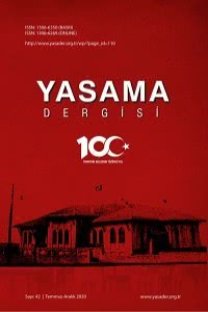Katılımcı Anayasa Yapımı ve İzlanda Örneği
Anayasa yapımı genellikle bir elit meselesi olarak algılanmıştır. Yirminci yüzyılın sonunda, özellikle demokratikleşme sürecindeki ülkelerde,demokratik bir anayasanın, sadece içeriğiyle değil yapım sürecinin dedemokratik olmasıyla mümkün olacağı düşüncesi ortaya çıkmıştır. Bunedenle halkın anayasa yapımı sürecine katılımını arttıran çeşitli uygulamalara başvurulmuştur. Çalışmada, öncelikle bizi katılımcı anayasa yapımı kavramını kullanmaya iten katılımcı demokrasi ve müzakereci demokrasi kavramları incelenecek, daha sonra anayasa yapımı sürecinekatılım uygulamaları açısından önemli bir örnek olarak İzlanda anayasayapımı süreci ele alınacaktır
Anahtar Kelimeler:
Anayasa yapımı, katılımcı demokrasi, müzakerecidemokrasi
Participatory Constitution Making And The Case Of Iceland
The constitution making is generally considered as an elite affair. In the latetwentieth century, especially in countries amid the democratisation process, ithas been thought that the making process of a constitution should also bedemocratic in order to form a democratic constitution. Therefore, practicesinvolving the public participation in the constitution making process havebeen applied. In t his study, the conceptions of participatory constitutionmaking, participatory democracy and deliberative democracy will beanalysed, followed by the review of the Iceland’s distinctive constitutionmaking process
___
- Akbulut, Olgun, “Doğrudan Demokrasi”, Yayımlanmamış Yüksek Lisans Tezi, İstanbul Üniversitesi Sosyal Bilimler Enstitüsü, 2001.
- Arato, Andrew, Constitution Making Under Occupation: The Politics of Impo- sed Revolution in Iraq, New York, Columbia University Press, 2009.
- Arato, Andrew, “Redeeming the Still Redeemable: Post Sovereign Constitution Making”, International Journal of Politics, Culture and Society, Vol. 22:4, s. 427-443.
- Banks, Angela M., “Expanding Participation in Constitution Making: Challen- ges and Opportunuties”, William and Mary Law Review, Vol. 49, Iss. 4, Art. 2, 2008, s. 1043-1069.
- Barber, Benjamin, Strong Democracy: Participatory Politics for a New Age, London, University of California Press, 2003.
- Bergsson, Baldwin Thor/Blokker, Paul “The Constitutional Experiment in Ice- land”, (çevrimiçi) http://ssrn.com/abstract=2320748, (erişim tarihi) 30.05.2014.
- Brandt, Michele/Cottrell,Jill/Ghai, Yash / Regan, Anthony: Constitution-making and Reform: Options for The Process, Interpeace, 2011.
- Catt, Helena, Democracy in Practice, London, Routledge, 1999.
- Chambers, Simone, “Constitutional Referendums and Democratic Deliberati- on”, Referendum Democracy: Citizens, Elites and Deliberation in Re- ferendum Campaigns, ed. Matthew Mendelsohn/Andrew Parkin, Palg- rave, 2001.
- Çağ, Burak, “Anayasa Yapımı Sürecinde Doğrudan Demokrasi Uygulamaları”, Yayımlanmamış Yüksek Lisans Tezi, İstanbul Üniversitesi Sosyal Bi- limler Enstitüsü, 2012.
- Elkins, Zachary/Ginsburg, Blount, Justin, “Citizen as Founders: Public Partici- pation in Constitutional Approval”, Temple Law Review, Vol. 81, No. 2, 2008.
- Elster, Jon, “Deliberation and Constitution Making”, Deliberative Democracy, ed. Jon Elster, Cambridge University Press, 1998, s. 97-123.
- Ersöz, Selva, “İnternet ve Demokrasinin Geleceği”, Selçuk Üniversitesi İletişim Fakültesi Dergisi, Vol.3 (4), 2005, s. 122-129.
- Gai, Yash, “The Role of Constituent Assemblies in Constitution Making”, (çev- rimiçi) ent_assemblies-final_yg-200606.pdf, (erişim tarihi: 01.03.2012).
- Ginsburg, Tom/Elkins, Zachary/Melton, James, “A Review of Iceland’s Draft Constitution”, (çevrimiçi) http://comparativeconstitutionspro- ject.org/wp-content/uploads/CCP-Iceland-Report.pdf, (erişim tarihi: 18.04.2013).
- Ginsburg, Tom, “Iceland: End of the constitutional Saga?, (çevrimiçi) http://www.huffingtonpost.com/tom-ginsburg/iceland-end-of-the-cons- ti_b_3018127.html, (erişim tarihi: 25.07.2013).
- Glassman, Michael/Kang, Min Ju, “Five Classrooms: Different forms of ‘de- mocracies’ and their relationship to cultural pluralism(s)”, Educational Philosophy and Theory, Vol. 43, No. 4, 2011, s. 365-386.
- Gözler, Kemal, Anayasa Hukukunun Genel Teorisi, I. Cilt, Ekin Yayınları, 2011.
- Gülener, Serdar, “Anayasa Yapımında Yeni Bir Paradigma: Kapsayıcı, Katılımcı, Uzlaşmacı Anayasa Yapım Süreçleri ve Çeşitli Örnekler”, Gazi Üniver- sitesi Hukuk Fakültesi Dergisi, C.XV, Y.2011, Sa. 3, s. 199-224.
- Gylfason, Thorvaldur, “From Collapse to Constitution: The Case of Iceland”, CESIFO Working Paper, No. 3770, 2012, (çevrimiçi) http://pa- pers.ssrn.com/sol3/papers.cfm?abstract_id=2034241, (erişim: 20.03.2012).
- Gylfason, Thorvaldur, “From Crisis to Constitution”, 2011, çevrimiçi: http://www.voxeu.org/index.php?q=node/7077, (erişim tarihi: 12.06.2012).
- Gylfason, Thorvaldur Gylfason, “Crowds and Constitutions”, 2011, çevrimiçi: http://www.voxeu.org/index.php?q=node/7090, (erişim tarihi: 17.02.2012).
- Gylfason, Thorvaldur, “Constitution-making in action: the case of Iceland”, (çevrimiçi) http://www.voxeu.org/article/constitution-making-action- case-iceland, (erişim tarihi: 20.04.2013).
- Gylfason, Thorvaldur, “Democracy on ice: a post mortem of the Icelandic Cons- titution, (çevrimiçi) http://www.opendemocracy.net/can-europe-make- it/thorvaldur-gylfason/democracy-on-ice-post-mortem-of-icelandic- constitution, (erişim tarihi: 25.07.2013).
- Hart, Vivien, “Democratic Constitution Making”, United States Institute of Pe- ace, Special Report, 2003.
- Hart, Vivien, “Constitution-Making and Transformation of Conflict”, Peace and Change, Vol. 26, No. 2, 2001.
- Lendemore, Helene, “Inclusive Constitution making: The Icelandic Experi- ment”, Journal of Political Philosophy. doi: 10.1111/jopp.12032, Şubat 2014 (çevrimiçi) https://www.academia.edu/5289629/Inclusive_Cons- titution-Making_the_Icelandic_Experiment, (erişim tarihi: 23.04.2014).
- Mueller, Dennis C., Constitutional Democracy, Oxford University Press, 2000.
- Orr, Aki, “Doğrudan Demokrasi Manifestosu”, çev. Murat Yanık, Prof.Dr. Aydın Aybay’a Armağan, Vedat Kitapçılık, 2004, s. 365-376.
- Posner, Richard A., Law, Pragmatism and Democracy, London, Harward Uni- versity Press, 2003.
- Rousseau, J. J., Toplum Sözleşmesi, çev. Vedat Günyol, Türkiye İş Bankası Kül- tür Yayınları, 2011.
- Sartori, Giovanni, Demokrasi Teorisine Geri Dönüş, çev. Tunçer Karamustafa- oğlu, Mehmet Turhan, Yetkin Yayınları, 1996.
- Tierney, Stephen, “Constituitonal Referandums: A Theoretical Enquiry”, The Modern Law Review, s. 72(3), 2009, s. 360-383.
- Voigt, Stefan, “The Consequences of Popular Participation in Constitutional Choice – Towards a Comparative Analys”, (çevrimiçi) http://www.uni- marburg.de/fb02/insecon/publikationendatenfiles/wittenberg.pdf, (eri- şim tarihi: 20.04.2012)
- Yanık, Murat, “Yeniden Doğrudan Demokrasi”, E-Akademi, S. 41, Temmuz 2005, (çevrimiçi) http://www.e-akademi.org/incele.asp?konu=Yeni- den%20Do%F0rudan%20Demokrasi&kimlik=1120134975&url=ma- kaleler/myanik-1.htm, (erişim tarihi: 2.11.2011).
- Yüksel, Saadet, “Turkey’s Procedural Challenges to Making a New Constituti- on”, Annales de la Faculte de Droit d’Istanbul, İstanbul, XLI, N. 58, 2009, s. 119-135. İnternet siteleri
- İzlanda Anayasa Konseyi Resmi Web Sitesi, http://stjornlagarad.is/english/
- Iceland Review Online, http://www.iceland.review.com
- The Guardian, http://www.guardian.co.uk/world
- İzlanda ulusal istatistik web sitesi, http://www.statice.is/Pages/444?New- sID=10348
- İzlanda Anayasası, http//www.government.is/constitution
- İzlanda 2013 Seçim Sonuçları, http://www.electionresources.org/is/
- ISSN: 1306-6250
- Yayın Aralığı: Yılda 2 Sayı
- Başlangıç: 2006
- Yayıncı: YASAMA DERNEĞİ
